Volkswagen Taos: Checking and filling
- In the engine compartment
- Operating fluids and operating equipment
- Washer fluid
- Engine oil
- Engine coolant
- Brake fluid
- 12 V vehicle battery
In the engine compartment
Safety precautions for working in the engine compartment
The engine compartment is a potentially dangerous area in the vehicle. Only
perform work in the engine compartment if you
are familiar with the necessary activities and the general safety precautions,
and if the correct operating equipment, fluids and
suitable tools are available. Work performed incorrectly can result in serious
injuries ⇒
 . Have all work performed
by
suitably qualified professionals if necessary. Volkswagen recommends contacting
an authorized Volkswagen dealer or
authorized Volkswagen Service Facility.
. Have all work performed
by
suitably qualified professionals if necessary. Volkswagen recommends contacting
an authorized Volkswagen dealer or
authorized Volkswagen Service Facility.
WARNING
The engine compartment is a dangerous area. Any work in the engine compartment could lead to accidents and serious or fatal injuries.
- Always work as cautiously and carefully as possible.
- Only perform work in the engine compartment if you are familiar with the required activities.
- If you are not sure how to do the work in the engine compartment, go to an authorized Volkswagen dealer or authorized Volkswagen Service Facility. Volkswagen recommends contacting an authorized Volkswagen dealer or authorized Volkswagen Service Facility.
- Before working in the engine compartment, apply the electronic
parking brake and move the selector lever to the
 position or move the gearshift lever into the neutral position.
position or move the gearshift lever into the neutral position. - Switch off the ignition and store the vehicle key securely and far enough away from the vehicle to ensure that the engine cannot be started accidentally.
- Never touch hot components in the engine.
- Do not leave any items, such as cleaning cloths or tools, in the engine compartment.
- Always keep children away from the engine compartment and never leave them unattended.
WARNING
The engine compartment contains moving components. When working in the engine compartment, particularly when starting the vehicle or if the engine is running, contact with moving parts, e.g. fan blades in the radiator fan, may cause serious or fatal injuries.
- Never reach into the radiator fan or into the area near the radiator fan, even if the engine is switched off or the ignition is switched off. The ventilator is temperature-controlled and may switch on by itself.
- To reduce the risk of anything becoming caught in engine components, always remove any jewelry and/or ties, tie back long hair, and avoid wearing loose-fitting clothing when performing work.
- Always press the accelerator pedal extremely carefully and never press it without paying close attention. The vehicle could begin moving, even if the electronic parking brake is set.
WARNING
Escaping hot steam or hot coolant and hot components may cause serious burns.
- Never open or close the hood if steam or engine coolant is escaping.
- Always wait until you can no longer see or hear steam or engine coolant escaping from the engine compartment.
WARNING
The engine cooling system is under pressure when the engine is hot. If the cover is opened carelessly, coolant may spray out and cause serious burns or fatal injuries.
- Never open the cap on the coolant expansion tank when the engine is hot.
- Always protect your face, hands and arms from hot coolant or steam with a large, thick cloth if you have to open the cover of the coolant tank.
- Slowly and very carefully turn the cap on the coolant expansion tank counterclockwise while pressing down lightly on the cap.
WARNING
Additional insulation, such as covers in the engine compartment or discarded items such as cleaning cloths or tools, can cause malfunctions, damage to the engine, or fires. This could result in serious or fatal injuries.
- Never cover the engine with blankets or other insulating materials.
- Never leave items in the engine compartment.
Always park the vehicle on a horizontal and firm surface before carrying
out any work on the engine compartment ⇒
 ,
⇒ Parking.
,
⇒ Parking.
WARNING
If the vehicle is not secured against rolling away during maintenance procedures, the vehicle may move unintentionally.
This could result in accidents and serious or fatal injuries.
- Manually deactivate the start-stop system.
- Never carry out any work underneath the vehicle unless it is adequately secured to prevent it from rolling.
- Ensure that the vehicle is situated on a horizontal and firm surface and that the wheels are blocked to prevent them from moving when carrying out work underneath the vehicle with its wheels touching the ground.
- If you are working underneath the vehicle, additionally support the vehicle securely with suitable stands. The vehicle jack is not sufficient for this purpose and may collapse.
WARNING
The high voltage in the electrical system may cause electric shocks and burns. This could result in serious or fatal injuries.
- Never short-circuit the electrical system. The 12 V vehicle battery may explode.
- Never touch the electrical wires and connections of the gas discharge lamps.
Preparing the vehicle for work in the engine compartment
Always perform the following activities in the specified sequence before all work in the engine compartment:
1. Safely park the vehicle on a horizontal and firm surface ⇒ Parking.
2. If necessary, remove the vehicle key from the vehicle and store it outside of the vehicle so that the vehicle does not start accidentally.
3. Let the engine cool down sufficiently.
4. Always keep other people away from the engine compartment.
5. Secure the vehicle against rolling away.
Opening and closing the hood
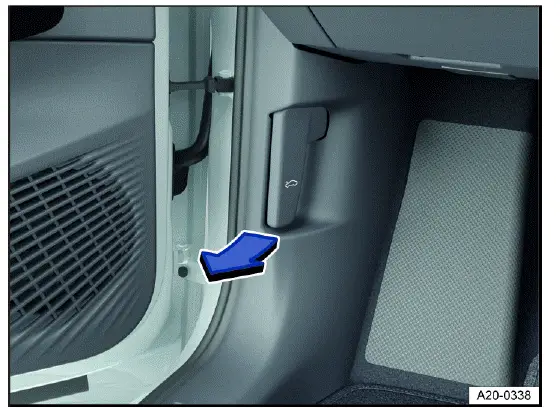
Fig. 162 In the driver's side footwell: Release lever for the hood (general
example).
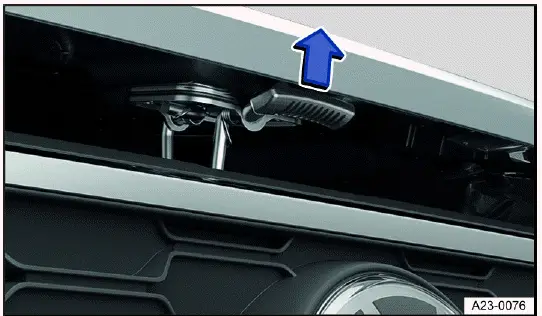
Fig. 163 Above the radiator grille: Opening lever for the hood (general
example).
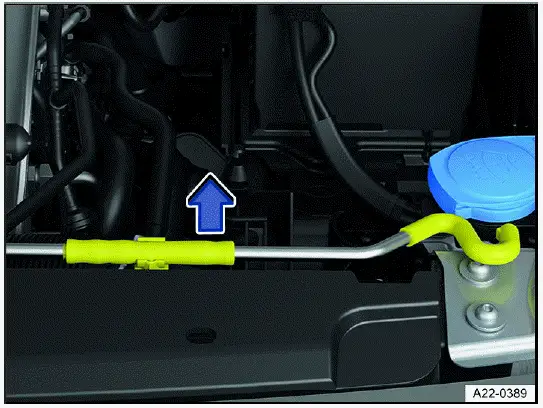
Fig. 164 In the engine compartment: Hood support in the bracket.
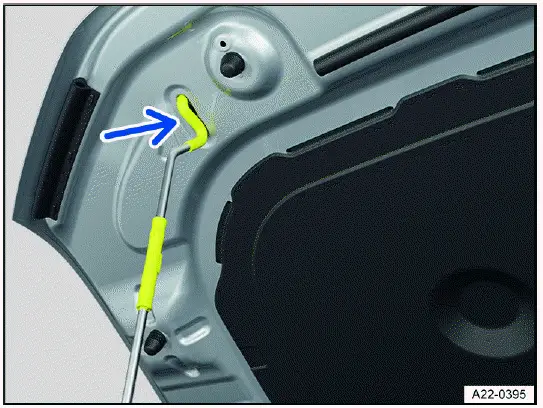
Fig. 165 On the engine hood: Hood support bracket (general example).
Opening the hood
1. Open the driver door and pull the release lever in the direction of the arrow fig. 162.
The hood will pop open due to spring force from the catch in the lock carrier ⇒
 .
.
2. To open the hood fully, slightly lift the hood while pushing the actuating lever in the direction of the arrow fig. 163.
3. Remove the hood support from the bracket in the direction of the arrow fig. 164 and insert it into the holder for the hood support fig. 165.
Closing the hood
1. Lift the hood slightly and hold it ⇒
 .
.
2. Unhook the hood support from the holder for the hood support fig. 165 and insert it into the bracket fig. 164.
3. Allow the hood to fall out approx. 20 cm (approx. 8 inches) into the catch of the lock carrier, without pressing down on it.
When the hood is closed correctly, it will be flush with the surrounding
sections of the vehicle body ⇒
 .
.
If the hood is not closed correctly, lift the hood up and try to close it again.
If the hood is not correctly closed, an indicator will appear in the display of the Volkswagen Digital Cockpit. Once the hood is correctly closed, the indicator will turn off.
WARNING
If the hood is not closed correctly, it could open suddenly while driving and block the view through the windshield.
Accidents and serious or fatal injuries could result.
- After closing the hood, check that the catch is engaged correctly in the lock carrier.
- If you realize when driving that the hood is not closed properly, park the vehicle safely and close the hood.
WARNING
Failing to take care when opening and closing the hood can result in serious injuries.
- Do not open or close the hood if any persons are in the closing range of the hood.
NOTICE
Opening and closing the hood incorrectly can cause damage to the hood or wiper arms.
- Only open the hood when wiper mode is switched off and with the windshield wipers folded in.
- Always fold the wiper arms against the windshield before driving.
Display
An image in the instrument cluster display indicates if the hood is open or
has not closed correctly ⇒
 .
.
 Do not continue driving!
Do not continue driving!
1. Stop the vehicle as soon as it is safe to do so.
2. If necessary, lift the hood and close it again.
The image is also displayed when the ignition is switched off and it disappears several seconds after the doors are closed and the vehicle is locked.
WARNING
Disregarding warning notifications could lead to breakdowns while driving, accidents and serious or fatal injuries.
- Never ignore warning notifications.
- Stop the vehicle as soon as it is safe to do so.
- Do not continue driving and seek professional assistance if the warning light does not go out.
Operating fluids and operating equipment
All fluids and operating equipment, such as engine coolant, engine oils and vehicle batteries, are continuously being developed. Have fluids and operating equipment replaced by suitably qualified professionals. Volkswagen recommends contacting an authorized Volkswagen dealer or authorized Volkswagen Service Facility.
WARNING
Carrying out work on the fuel system may cause fires and serious or fatal injuries due to electrical discharge and flying sparks.
- Always disconnect the 12 V vehicle battery.
- Always have a fully-functioning, checked fire extinguisher nearby.
- Make sure that the vehicle is unlocked when the 12 V vehicle battery is disconnected. Otherwise, the anti-theft alarm system will be activated.
WARNING
Fluids may be poisonous. Improper use and storage may cause serious or fatal injuries.
- Only store fluids in their sealed original containers.
- Never use empty food cans, bottles, or other containers to store fluids, because someone could drink the fluids by mistake.
- Keep children away from all fluids and operating equipment.
- Always read and heed the information and warnings on the packaging for the fluids.
- When using products that emit harmful vapors, always work outdoors or in a well-ventilated area.
WARNING
Fluids and some materials in the engine compartment are highly flammable and may ignite on contact with hot surfaces, sparks or naked flames. This can lead to a fire and cause accidents and serious or fatal injuries.
- Never smoke near the engine compartment.
- Never work near open flames or sparks.
- Never perform work near sources of heat, boilers, or other open flames.
- Never pour or spill fluids on the engine.
- Always have a fully-functioning, checked fire extinguisher nearby.
NOTICE
The use of fluids that do not correspond to the specification can cause serious malfunctions and damage to the engine.
- When topping up or changing fluids, make sure that the fluids correspond to the respective specification.
- Only fill fluids into the designated filler openings.
Fluids leaking from the vehicle can cause environmental damage.
1. Regularly check the ground beneath the vehicle.
2. If you see spots of fluid on the ground under the vehicle, have the vehicle checked by an authorized Volkswagen dealer or authorized Volkswagen Service Facility. Volkswagen recommends contacting an authorized Volkswagen dealer or authorized Volkswagen Service Facility.
3. Dispose of leaking fluids correctly.
Washer fluid
General information
The windshield washer fluid reservoir is located in the engine compartment.
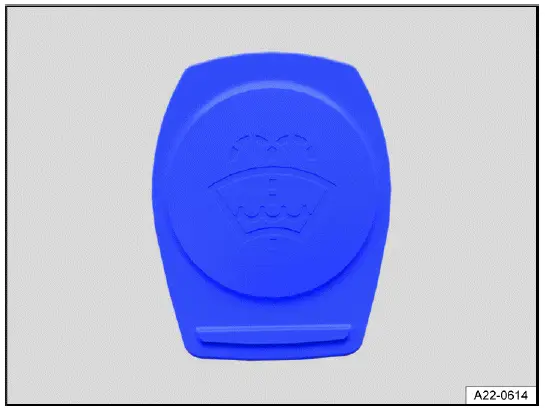
Fig. 166 In the engine compartment: Cap on the washer fluid reservoir
(general example).
The washer fluid reservoir is identified with the
 symbol on the cap fig. 166.
symbol on the cap fig. 166.
1. Check the washer fluid level regularly and fill if necessary.
Preparations
1. Prepare the vehicle for work in the engine compartment → page, In the engine compartment.
2. Open the hood.
Checking and refilling
1. Check if there is enough washer fluid in the reservoir.
2. To top it up, mix clean water with a suitable alcohol-based windshield
cleaner. Follow the mixing instructions on the
packaging of the windshield cleaner ⇒
 , ⇒
, ⇒
 .
.
3. When the outside temperatures are cold, an anti-freeze agent should be added to the water so that it does not freeze.
Follow the mixing instructions on the packaging of the anti-freeze agent.
There is a screen in the filler tube in the windshield washer fluid reservoir.
The screen keeps large particles of contaminants
from entering the washer nozzles when you refill the washer fluid ⇒
 .
.
 Do not use distilled water to
fill the windshield washer fluid tank.
Do not use distilled water to
fill the windshield washer fluid tank.
WARNING
Unsuitable additives in the windshield washer fluid can create an oily film on the vehicle windshield. This may reduce visibility and increase the risk of accidents and serious or fatal injuries.
- Never add coolant additive or similar unsuitable additives to the windshield washer fluid.
NOTICE
Using a cleaning agent that contains acid may result in damage and cause the spray nozzles to malfunction.
- Never top up the windshield washer fluid tank using a cleaning agent that contains acid, e.g. vinegar-based cleaners.
NOTICE
Mixing different windshield cleaners can cause the components to flocculate and the spray nozzles to clog.
- Only use suitable alcohol-based windshield cleaners.
- Never mix different windshield cleaners together.
NOTICE
When you top up the windshield washer fluid, if you use a damaged screen or do not use a screen at all, dirt particles may get into the windshield washer fluid tank. The spray nozzles may become clogged.
- Take the screen out only to clean it.
- Replace a damaged or missing screen.
Engine oil
Introduction
The engine oils are determined based on the requirements of the engines, emissions control systems, and the fuel quality. On all combustion engines, the engine oil comes into contact with combustion residue and fuel, which affects the aging of the engine oil. Using the correct engine oil is essential for the function and service life of the engine. The vehicle is filled at the factory with a special multi-purpose, low-viscosity oil that can generally be used year-round.
The vehicle can consume engine oil. The engine oil consumption can vary and can change throughout the service life of the vehicle. Depending on the driving style and the usage conditions, the engine oil consumption can be up to 1 l (1 qt) per 2000 kilometers (1200 miles); it can also be higher within the first 5000 kilometers (3100 miles) on new vehicles. Because of this, the engine oil level must be checked regularly and it is best to check the level before long drives.
WARNING
Engine oil gets extremely hot when the engine is running. Failure to take care when handling hot engine oil can cause serious bodily burns. This could result in serious or fatal injuries.
- Always allow the engine to cool down before starting work with the engine oil.
WARNING
Engine oil is poisonous. Contact with engine oil, especially swallowing engine oil, may result in serious or fatal injuries.
- If you swallow engine oil, seek urgent medical help.
- If you have health problems after working with engine oil, seek medical help.
- Always store engine oil in the sealed original container and keep it out of the reach of children. This also applies to used oil until it is disposed.
- Never use empty food cans, bottles, or other containers to store engine oil, because someone could drink the engine oil by mistake.
- Avoid regular contact with engine oil to prevent damage to your skin.
- Protect your skin, face and particularly your eyes when working with engine oil.
- Do not eat, drink or smoke when working with engine oil.
- Wash your skin with soap and water after working with engine oil.
 Engine oil that has dripped and
spilled can pollute the environment. Catch any leaking operating fluids and
dispose of
them correctly according to environmental regulations.
Engine oil that has dripped and
spilled can pollute the environment. Catch any leaking operating fluids and
dispose of
them correctly according to environmental regulations.
Engine oil standards
Please read the introductory information and heed the Warnings and
Notice ⇒
 Safety
precautions for working in the
engine compartment.
Safety
precautions for working in the
engine compartment.
Engine oil label
There is a label on the lock carrier at the front of the engine compartment that shows which engine oil should be added fig. 167.
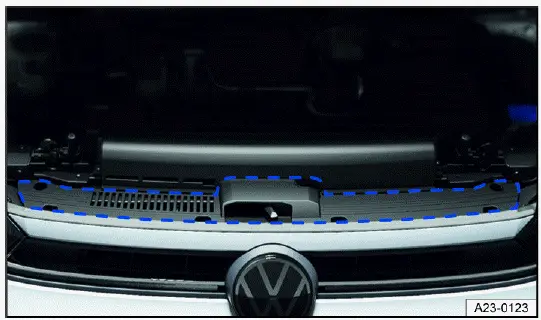
Fig. 167 In the marked area: space for the sticker for engine oil standard
and engine oil viscosity (general example).
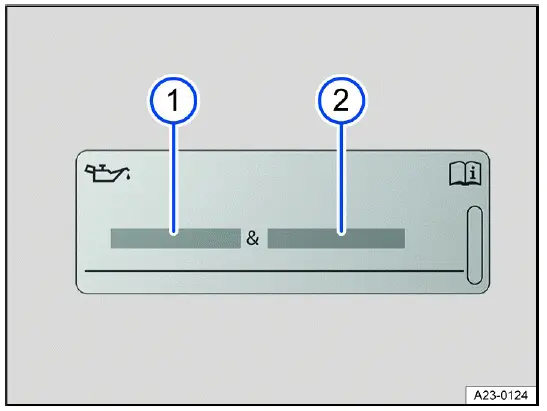
Fig. 168 Engine oil standard and engine oil viscosity label (general
example).
- Engine oil viscosity information.
- Engine oil standard information.
If the prescribed engine oil is used fig. 168, the engine oil level can be corrected any number of times as needed ⇒ Checking the engine oil level and adding oil.
If no engine oil that meets the prescribed standard is available, you may, in an emergency, top up the engine oil no more than once before your next standard oil change using no more than 0.5 l (0.5 qt) of engine oil that meets the following deviating standards:
- Gasoline engines: VW standard 504 00 and ACEA C3, ACEA C4, API SP or ILSAC GF-6A. All viscosity classes in these standards are permitted.
Having the oil change carried out by an authorized Volkswagen dealer or authorized Volkswagen Service Facility is recommended. Volkswagen recommends contacting an authorized Volkswagen dealer or authorized Volkswagen Service Facility.
NOTICE
Using engine oils that have not been approved in accordance with the respective VW standard can cause damage to the engine.
- When refilling, only use engine oils that comply with the quality requirements of the respectively applicable VW standard.
- Only if you absolutely must, add max. 0.5 l (0.5 qt) of engine oil that does not comply with the specified engine oil standards.
 Volkswagen recommends
Volkswagen Genuine oil.
Volkswagen recommends
Volkswagen Genuine oil.
Changing the engine oil
Please read the introductory information and heed the Warnings and
Notice ⇒
 Safety
precautions for working in the
engine compartment.
Safety
precautions for working in the
engine compartment.
The engine oil must be changed regularly and in line with the service intervals → page, Information About Service.
Additives in the engine oil can make new engine oil appear dark after a brief engine run time. This is normal and is no reason to change the engine oil more frequently.
WARNING
If care is not taken when changing engine oil, the oil can cause environmental damage, serious burns, or fire. This could result in serious or fatal injuries.
- Always allow the engine to cool down completely before the engine oil change.
- Always wear eye protection for the engine oil change.
- Keep your arms horizontal when using your fingers to unscrew the oil drain plug, so that the draining oil does not drip down your arm.
- Use a container suitable for collecting used oil that can hold at least the entire quantity of oil in the engine.
NOTICE
Changing the engine oil and filter requires special tools and specialist knowledge. Failing to act properly may cause damage to the vehicle.
- For this reason, always have the engine oil and filters changed by an authorized Volkswagen dealer or authorized Volkswagen Service Facility. Volkswagen recommends contacting an authorized Volkswagen dealer or authorized Volkswagen Service Facility.
 Dispose of the engine oil in a
way that will not harm the environment and only at a collection point for used
oil, e.g. a
recycling center or specialist retailer.
Dispose of the engine oil in a
way that will not harm the environment and only at a collection point for used
oil, e.g. a
recycling center or specialist retailer.
Checking the engine oil level and adding oil
Please read the introductory information and heed the Warnings and
Notice ⇒
 Safety
precautions for working in the
engine compartment.
Safety
precautions for working in the
engine compartment.
Preparations
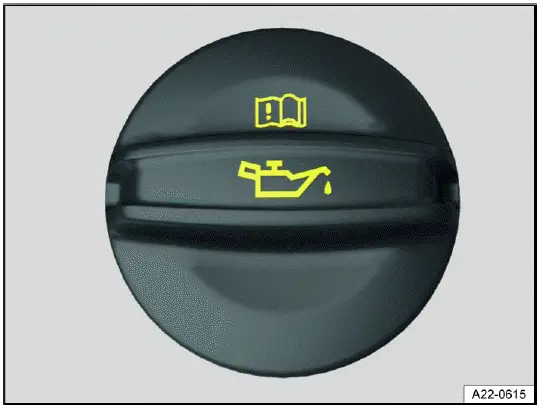
Fig. 169 In the engine compartment: engine oil filler cap (general example).
To avoid an incorrect oil level reading, perform the following steps:
1. With the engine warm from operation, safely park the vehicle on a horizontal and firm surface ⇒ Parking.
2. Wait at least five minutes for the engine oil to flow back into the oil pan.
3. Open the hood.
4. Find the engine oil filler and the dipstick.
You can identify these by the
 fig.
169 symbol on the engine oil filler cap and the colored handle on the oil
dipstick.
fig.
169 symbol on the engine oil filler cap and the colored handle on the oil
dipstick.
Checking the engine oil level
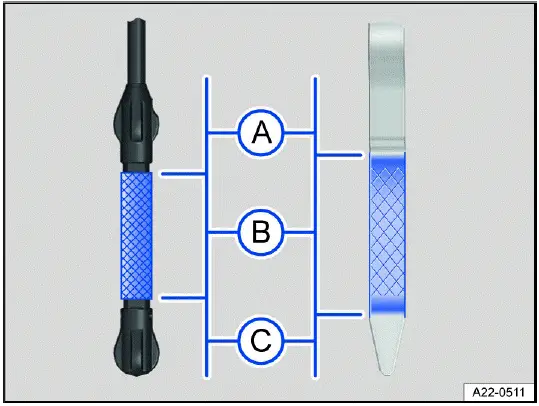
Fig. 170 Engine oil level markings on the oil dipstick (versions).
- The engine oil level is too high.
- Oil level in the normal range.
- The engine oil level is too low.
1. Remove the dipstick from the guide tube and wipe the dipstick off using a clean cloth.
2. Reinsert the dipstick into the guide tube and push it all the way in. If there is an alignment tab on the top of the engine oil dipstick, make sure it lines up with the notch in the guide tube, and that the dipstick goes all the way in.
3. Remove the dipstick again and read the oil level on the dipstick as described below fig. 170:
- The engine oil level is too high. If necessary, follow the messages in
the instrument cluster display or contact an
authorized Volkswagen dealer or authorized Volkswagen Service Facility ⇒
 .
. - Oil level in the normal range. Engine oil can be added up to the upper edge of this area, for example if there is heavy engine load.
- The engine oil level is too low. Add engine oil immediately.
4. After reading the oil level, reinsert the oil dipstick into the guide tube and push it all the way in.
For high vehicle loads, for example when driving long distances on highways in the summer or when driving through high mountains, the engine oil level should be in the upper section of the permitted area.
Adding engine oil
WARNING
When you top up the engine oil, it could spill or overflow and ignite on contact with engine parts that are hot or may heat up. This may cause burns or a fire. This could result in serious or fatal injuries.
- Always make sure that the engine oil cap is installed securely on the engine filler opening after adding oil and that the oil dipstick is inserted correctly in the guide tube.
- Always use a suitable filling aid when topping up the engine oil.
Only perform these activities in the specified order ⇒
 ⇒
⇒
 :
:
1. Remove the cap on the engine oil filler fig. 169.
2. Top up the engine oil gradually in small quantities, not more than 0.5 l (0.5 quart), or follow the recommendation in the display of the Volkswagen Digital Cockpit. Volkswagen recommends using the approved engine oils in accordance with the respective VW standard.
3. To avoid overfilling, you must wait at least one minute each time you add engine oil so that the engine oil can flow into the oil pan up to the marking on the oil dipstick.
4. Read the oil level on the dipstick again before adding a little more. Never add too much oil.
When you are done adding oil, the oil level should be in the center of area fig. 170 B. The engine oil level must not be in the area fig. 170 A.
5. If you accidentally add too much engine oil and the engine oil level is in
area fig. 170 A, do not start the engine ⇒
 .
.
Contact an authorized Volkswagen dealer or authorized Volkswagen Service Facility for assistance.
6. Close the cap on the engine oil filler when you are done adding engine oil.
7. Insert the oil dipstick all the way into the guide tube. If there is an alignment tab on the top of the engine oil dipstick, make sure it lines up with the notch in the guide tube, and that the dipstick goes all the way in.
8. Close the hood.
NOTICE
Starting the engine with the engine oil level too high after refilling can cause engine damage.
- Do not start the engine, and seek professional assistance.
NOTICE
Using incorrect fluids can result in malfunctions and engine damage.
- When topping up fluids, make sure the correct fluids are added to the correct reservoirs.
 Volkswagen recommends using
the approved engine oils in accordance with the respective VW standard.
Volkswagen recommends using
the approved engine oils in accordance with the respective VW standard.
 If you are not sure where
the cap and the oil dipstick are located, contact an authorized Volkswagen
dealer or authorized
If you are not sure where
the cap and the oil dipstick are located, contact an authorized Volkswagen
dealer or authorized
 Volkswagen Service Facility
for assistance. Volkswagen recommends contacting an authorized Volkswagen dealer
or
authorized Volkswagen Service Facility.
Volkswagen Service Facility
for assistance. Volkswagen recommends contacting an authorized Volkswagen dealer
or
authorized Volkswagen Service Facility.
Troubleshooting
Please read the introductory information and heed the Warnings and
Notice ⇒
 Safety
precautions for working in the
engine compartment.
Safety
precautions for working in the
engine compartment.
 Engine oil pressure too low
Engine oil pressure too low
The red warning light blinks. A message is shown in the instrument cluster display.
 Do not continue driving! Engine
damage could result.
Do not continue driving! Engine
damage could result.
1. Stop the vehicle as soon as it is safe to do so ⇒ Parking.
2. Stop the engine.
3. Check the engine oil level ⇒ Checking the engine oil level and adding oil.
4. If the warning light flashes, do not continue driving or let the engine run, even if the oil is at the correct level. Engine damage could result. Contact an authorized Volkswagen dealer or authorized Volkswagen Service Facility for assistance.
 Engine oil level very low
Engine oil level very low
The red warning light blinks. A message is shown in the instrument cluster display.
 Do not continue driving! Engine
damage could result.
Do not continue driving! Engine
damage could result.
1. Stop the vehicle as soon as it is safe to do so ⇒ Parking.
2. Stop the engine.
3. Check the engine oil level ⇒ Checking the engine oil level and adding oil.
4. If necessary, top up the engine oil gradually in small quantities (not more than 0.5 l (0.5 qt) in total) or observe the top-up recommendation in the display of the Volkswagen Digital Cockpit.
5. If the warning light lights up, do not continue driving or let the engine run, even if the oil is at the correct level. Engine damage could result. Contact an authorized Volkswagen dealer or authorized Volkswagen Service Facility for assistance.
 Engine oil level too low
Engine oil level too low
The yellow indicator light turns on. A message is shown in the instrument cluster display.
1. Stop the vehicle as soon as it is safe to do so ⇒ Parking.
2. Stop the engine.
3. Check the engine oil level ⇒ Checking the engine oil level and adding oil.
4. If necessary, top up the engine oil gradually in small quantities (not more than 0.5 l (0.5 qt) in total) or observe the top-up recommendation in the display of the Volkswagen Digital Cockpit.
5. If the indicator light comes on, do not continue driving or let the engine run, even if the oil is at the correct level. Engine damage could result. Contact an authorized Volkswagen dealer or authorized Volkswagen Service Facility for assistance.
 Engine oil level too high
Engine oil level too high
The yellow indicator light turns on. A message is shown in the instrument cluster display.
1. Stop the vehicle as soon as it is safe to do so ⇒ Parking.
2. Stop the engine.
3. Check the engine oil level ⇒ Checking the engine oil level and adding oil.
4. If the engine oil level is too high, do not drive any further or leave the engine running. Engine damage could result. Contact an authorized Volkswagen dealer or authorized Volkswagen Service Facility for assistance.
 or
or
 Engine oil system malfunction
Engine oil system malfunction
The indicator light flashes yellow. A message is shown in the instrument cluster display.
1. Contact a suitably qualified professional. Volkswagen recommends contacting an authorized Volkswagen dealer or authorized Volkswagen Service Facility.
Engine coolant
Introduction
Only perform work on the engine cooling system if you are familiar with the
necessary activities and the general safety
precautions, and if the correct operating equipment, fluids and suitable tools
are available. Work performed incorrectly can
result in serious injuries ⇒
 . Have
all work performed by suitably qualified professionals if necessary. Volkswagen
recommends contacting an authorized Volkswagen dealer or authorized Volkswagen
Service Facility.
. Have
all work performed by suitably qualified professionals if necessary. Volkswagen
recommends contacting an authorized Volkswagen dealer or authorized Volkswagen
Service Facility.
Information about warning and indicator lights can be found in the troubleshooting section at the end of the chapter ⇒ Troubleshooting.
WARNING
Engine coolant is poisonous. Contact with coolant, especially swallowing coolant, may result in serious or fatal injuries.
- If you swallow coolant, seek urgent medical help.
- If you have health problems after working with coolant, seek medical help.
- Always store engine coolant out of the reach of children and only within the sealed original container.
- Never use empty food cans, bottles, or other containers to store engine coolant, because someone could drink the engine coolant by mistake.
- Avoid regular contact with coolant to prevent damage to your skin.
- Protect your skin, face, and particularly your eyes when working with coolant.
- Do not eat, drink, or smoke when working with coolant.
- Wash your skin with soap and water after working with coolant.
WARNING
In extremely low temperatures, the coolant can freeze and the vehicle could break down. This can cause the heating to stop working in the vehicle. Vehicle occupants could die of exposure if they do not have sufficient warm clothing.
- Make sure the coolant additive is always adjusted according to the ambient temperature.
- Only use coolant additive approved by the manufacturer.
 Coolant and coolant additives
can pollute the environment. Catch any leaking operating fluids and dispose of
them
correctly according to environmental regulations.
Coolant and coolant additives
can pollute the environment. Catch any leaking operating fluids and dispose of
them
correctly according to environmental regulations.
Engine coolant specifications
Please read the introductory information and heed the Warnings and
Notice ⇒
 Safety
precautions for working in the
engine compartment.
Safety
precautions for working in the
engine compartment.
The cooling system is filled at the factory with a mixture of specially prepared water and at least 40% coolant additive G12evo (TL 744-L).
The proportion of coolant additive must always be at least 40% to protect the engine cooling system. If greater freeze protection is needed due to the climate, the proportion of coolant additive can be increased. However, the proportion of coolant additive must not exceed 55%, because otherwise the freeze protection will be reduced and the cooling effect will be decreased.
The engine coolant additive can be recognized by its violet color. The mixture of water and coolant additive provides freeze protection down to approx. -25 ºC (approx. -13 ºF), protects the light-alloy parts in the cooling system against corrosion, prevents calcium deposits and significantly increases the boiling point of the coolant.
If the engine coolant is being topped up, a blend of distilled water and at
least 40% of the G12evo engine coolant additive must be used to ensure optimum
corrosion protection ⇒
 .
.
NOTICE
The coloring of the engine coolant results from the mixture of the purple coolant additive and distilled water. If the fluid in the coolant expansion tank is not purple, but for example brown, the engine coolant has been mixed with another nonsuitable coolant. This may result in serious malfunctions or damage to the drive and cooling system.
- Only use coolant additive approved by the manufacturer.
- If the coolant turns brown, have it changed immediately by an authorized Volkswagen dealer or authorized Volkswagen Service Facility. Volkswagen recommends contacting an authorized Volkswagen dealer or authorized Volkswagen Service Facility.
- Never mix original Volkswagen coolant additives with coolant additives that are not approved by Volkswagen when topping up.
Engine coolant and coolant additives can harm the environment.
1. Catch any leaking operating fluids and dispose of them correctly according to environmental regulations.
Checking and filling engine coolant
Please read the introductory information and heed the Warnings and
Notice ⇒
 Safety
precautions for working in the
engine compartment.
Safety
precautions for working in the
engine compartment.
Preparations
1. Safely park the vehicle on a horizontal and firm surface ⇒ Parking.
2. Allow the engine to cool ⇒
 .
.
3. Open the hood.
The coolant expansion tank is identified with the
 red symbol on the cap fig. 171.
red symbol on the cap fig. 171.
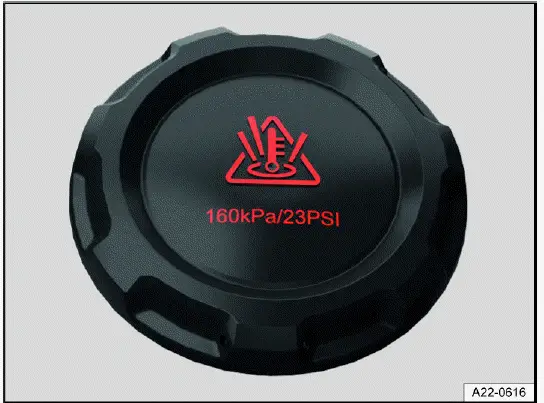
Fig. 171 In the engine compartment: cap on the engine coolant expansion tank.
WARNING
Escaping hot steam or hot coolant and hot components may cause serious burns.
- Never open the engine hood if you can see or hear steam or coolant escaping from the engine compartment.
- Always wait until you can no longer see or hear steam or engine coolant escaping from the engine compartment.
WARNING
The engine cooling system is under pressure when the engine is hot. If the cover is opened carelessly, coolant may spray out and cause serious burns or fatal injuries.
- Never open the cap on the coolant expansion tank when the engine is hot.
- Always protect your face, hands and arms from hot coolant or steam with a large, thick cloth if you have to open the cover of the coolant tank.
- Slowly and very carefully turn the cap on the coolant expansion tank counterclockwise while pressing down lightly on the cap.
Checking the coolant level
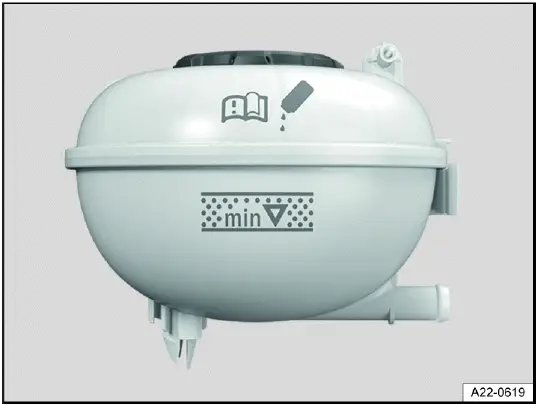
Fig. 172 In the engine compartment: markings on the engine coolant expansion
tank.
When new vehicles are delivered or after repairs to the cooling system, the coolant level may be above the marked area. This is normal. The coolant does not need to be extracted.
The coolant level cannot be checked exactly for every model, because the view of the fluid level in the coolant expansion tank may be obstructed. If you cannot read off the engine coolant level accurately, contact a suitably qualified professional.
Volkswagen recommends contacting an authorized Volkswagen dealer or authorized Volkswagen Service Facility.
1. When the engine is cold, check the coolant level using the markings on the side of the engine coolant expansion tank fig. 172. The coolant level must be between the markings.
2. If the fluid level in the coolant expansion tank is below the minimum mark ("min"), have coolant added. When the engine is warm, the engine coolant level may be slightly above the upper marking.
3. If no coolant is visible in the coolant expansion tank, do not add coolant ⇒
 .
.
Filling the coolant
1. Carefully unscrew the cap ⇒
 .
.
2. Only add new coolant that conforms to the Volkswagen specification ⇒ Engine coolant specifications.
If there is no engine coolant available that conforms to the required specification, initially only top up with distilled water.
Then have the correct mixture ratio using the specified coolant additive
restored as soon as possible by an authorized
Volkswagen dealer or authorized Volkswagen Service Facility. Volkswagen
recommends contacting an authorized
Volkswagen dealer or authorized Volkswagen Service Facility ⇒
 .
.
3. Top up the engine coolant to the upper fill level marker. After topping up the engine coolant, the coolant level must be between the markings on the coolant expansion tank fig. 172.
4. Install the cap securely.
5. Check the coolant level after one day. If the fill level of the coolant reservoir again drops below the "min" minimum marking, contact an authorized Volkswagen dealer or authorized Volkswagen Service Facility and have the cooling system checked. Volkswagen recommends contacting an authorized Volkswagen dealer or authorized Volkswagen Service Facility.
NOTICE
Coolant expands when it heats up. If coolant is topped up above the marked level, excess coolant may leak out and cause damage to the vehicle.
- Do not refill the system with engine coolant above the upper edge of the marked area of the engine coolant tank.
NOTICE
If there is no more engine coolant in the coolant expansion tank, air can get into the cooling system. This could result in damage to the engine.
- Do not continue driving.
- Do not top up the coolant.
- See an authorized Volkswagen dealer or authorized Volkswagen Service Facility for assistance.
NOTICE
The chemical components contained in water that is not distilled can cause considerable corrosion damage in the engine.
This can cause engine malfunctions.
- Only use distilled water for refilling the system!
- If you have added water that is not distilled, have the fluid in the cooling system changed completely by an authorized Volkswagen dealer or authorized Volkswagen Service Facility. Volkswagen recommends contacting an authorized Volkswagen dealer or authorized Volkswagen Service Facility.
NOTICE
The use of incorrect fluids can cause serious malfunctions and damage to the engine.
- When filling or changing fluids, make sure the correct fluids are added to the corresponding reservoirs.
Troubleshooting
Please read the introductory information and heed the Warnings and
Notice ⇒
 Safety
precautions for working in the
engine compartment.
Safety
precautions for working in the
engine compartment.
 Engine coolant
Engine coolant
The red warning light blinks. The coolant temperature is too high or the coolant level is too low.
 Do not continue driving! Engine
damage could result.
Do not continue driving! Engine
damage could result.
1. Stop the vehicle as soon as it is safe to do so ⇒ Parking.
2. Stop the engine.
3. Allow the engine to cool.
4. Check the engine coolant level on the Coolant expansion tank ⇒ Checking and filling engine coolant.
5. If the warning light does not turn off, do not continue driving or let the engine run, even if the engine coolant is at the correct level.
6. Contact an authorized Volkswagen dealer or authorized Volkswagen Service Facility for assistance.
Brake fluid
Introduction
Brake fluid absorbs moisture from the air over the course of time. Too much water in the brake fluid causes damage to the brake system. Water lowers the boiling point of the brake fluid. If the water content in the brake fluid is too high, vapor lock may form in the brake system during heavy braking and full braking. Vapor lock reduces the braking efficiency, increases the braking distance considerably, and can lead to a total failure of the brake system. Your own safety and the safety of others on the road depends on your brake system functioning correctly at all times.
WARNING
Brake fluid is poisonous. Contact with brake fluid - in particular, if brake fluid is swallowed - may result in serious injury or death.
- If you swallow brake fluid, seek urgent medical help.
- If you have health problems after working with brake fluid, seek medical help.
- Always store brake fluid out of the reach of children and only within the sealed original container.
- Never use empty food cans, bottles, or other containers to store brake fluid, because someone could drink the brake fluid by mistake.
- Avoid regular contact with brake fluid to prevent damage to your skin.
- Protect your skin, face, and particularly your eyes when working with brake fluid.
- Do not eat, drink, or smoke when working with brake fluid.
- Wash your skin with soap and water after working with brake fluid.
NOTICE
Spilled or leaking brake fluid will damage the vehicle's surfaces. The vehicle's paint, plastic parts, and tires may be damaged.
- Immediately wipe up any spilled or leaking brake fluid that comes into contact with vehicle components.
- Then rinse all vehicle parts with plenty of water.
 Brake fluid can pollute the
environment. Collect spilled brake fluid and dispose of it correctly.
Brake fluid can pollute the
environment. Collect spilled brake fluid and dispose of it correctly.
Brake fluid specifications
Please read the introductory information and heed the Warnings and
Notice ⇒
 Safety
precautions for working in the
engine compartment.
Safety
precautions for working in the
engine compartment.
Volkswagen has developed a special brake fluid that is optimized for the vehicle's brake system. For optimum performance of the brake system, Volkswagen recommends only using brake fluid that complies with the VW standard 501 14.
Before using brake fluid, check that the brake fluid specification on the bottle matches the vehicle requirements.
Brake fluid that complies with the VW standard 501 14 can be obtained from an authorized Volkswagen dealer or authorized Volkswagen Service Facility.
If this type of brake fluid is not available and it is therefore necessary to use a different high-quality brake fluid instead, a brake fluid that meets the requirements of DIN ISO 4925 or the US standard FMVSS 116 DOT 4 CLASS 6 can be used.
Not all brake fluids that comply with the requirements of DIN ISO 4925 or US Standard FMVSS 116 DOT 4 CLASS 6 have the same chemical composition. Some of these brake fluids can contain chemicals that can destroy or damage components of the vehicle brake system over time.
Brake fluid that complies with the VW standard 501 14 meets the requirements of DIN ISO 4925 or the US Standard FMVSS 116 DOT 4 CLASS 6.
Checking the Brake Fluid
Please read the introductory information and heed the Warnings and Notice ⇒ Safety precautions for working in the engine compartment.
Preparations
1. Safely park the vehicle on a horizontal and firm surface ⇒ Parking.
2. Open the hood.
Checking the Brake Fluid Level
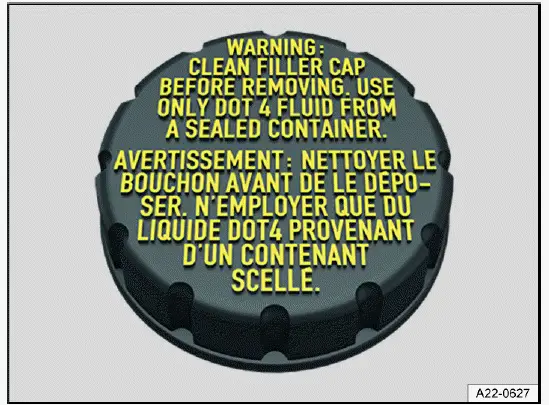
Fig. 173 In the engine compartment: cap on the brake fluid reservoir.
The brake fluid reservoir can be recognized by its cap fig. 173.
The brake fluid level cannot be checked precisely on all models because the hood or engine components may obstruct the view of the fluid level in the reservoir.
- If you cannot read the brake fluid level clearly, see an authorized Volkswagen dealer or authorized Volkswagen Service Facility for assistance. Volkswagen recommends contacting an authorized Volkswagen dealer or authorized Volkswagen Service Facility.
- If the brake fluid level is not between the min. and max. marking on the
brake fluid reservoir, contact an authorized
Volkswagen dealer or authorized Volkswagen Service Facility ⇒
 .
Volkswagen recommends contacting an
authorized Volkswagen dealer or authorized Volkswagen Service Facility.
.
Volkswagen recommends contacting an
authorized Volkswagen dealer or authorized Volkswagen Service Facility.
The brake fluid level decreases slightly when the vehicle is being used as the brake pads wear and the brakes automatically adjust themselves.
WARNING
A low brake fluid level or unsuitable brake fluid may cause the brakes to fail or may reduce braking efficiency. Accidents and serious or fatal injuries could result.
- Have the brake system and brake fluid level checked regularly.
- Be sure to use the correct brake fluid.
- Only use brake fluid that expressly complies with the VW standard 501 14.
- In the exceptional case that a brake fluid that conforms to VW standard 501 14 is not available, use only a highquality brake fluid that complies with DIN ISO 4925 CLASS 6 or the US standard FMVSS 116 DOT 4.
Changing brake fluid
Have the brake fluid changed regularly. An authorized Volkswagen dealer or authorized Volkswagen Service Facility can provide information about the interval for changing the vehicle brake fluid. Volkswagen recommends contacting an authorized Volkswagen dealer or authorized Volkswagen Service Facility.
1. Only have brake fluid added that meets the required specifications.
WARNING
Vapor lock may occur in old brake fluid due to absorbed moisture during hard braking, reducing braking efficiency and potentially causing total brake failure. Accidents and serious or fatal injuries could result.
- Have the brake fluid changed regularly.
- Only have new brake fluid added.
Troubleshooting
Please read the introductory information and heed the Warnings and Notice ⇒ Safety precautions for working in the engine compartment.
Brake fluid level
 Brake fluid level
Brake fluid level
The red warning light turns on. The brake fluid level is too low.
 Do not continue driving! This
could result in the brake failing.
Do not continue driving! This
could result in the brake failing.
1. Stop the vehicle immediately as soon as it is safe to do so ⇒ Parking.
2. Check the brake fluid level.
3. If the brake fluid level is too low, contact an authorized Volkswagen dealer or authorized Volkswagen Service Facility.
12 V vehicle battery
Introduction
The 12-volt vehicle battery is a component of the electrical system and serves to supply energy to the vehicle. During maintenance procedures, the 12 V vehicle battery is checked and replaced if necessary.
You may only perform procedures on the electrical system yourself if you are
familiar with the necessary activities and the
general safety precautions, and if the correct operating equipment and fluids
and suitable tools are available. Work performed
incorrectly can result in serious injuries ⇒
 .
Have all work performed by suitably qualified professionals. Volkswagen
recommends contacting an authorized Volkswagen dealer or authorized Volkswagen
Service Facility.
.
Have all work performed by suitably qualified professionals. Volkswagen
recommends contacting an authorized Volkswagen dealer or authorized Volkswagen
Service Facility.
Information about warning and indicator lights can be found in the troubleshooting section at the end of the chapter ⇒ Troubleshooting.
Battery switch-off in an accident with triggering of the airbag
In vehicles with a 12 V vehicle battery in their vehicle interior or luggage compartment, the electrical connection to the 12 V vehicle battery is pyrotechnically disconnected in an accident with airbag deployment. This prevents a short circuit. For more information on the installation location of the vehicle battery, refer to section → page, Checking the 12 V vehicle battery acid level.
Detailed warnings for the 12 V vehicle battery
 Always wear eye protection.
Always wear eye protection.
 Battery acid is highly corrosive.
Always wear protective gloves and eye protection.
Battery acid is highly corrosive.
Always wear protective gloves and eye protection.
 Fire, sparks, open flame are forbidden.
Fire, sparks, open flame are forbidden.
 A highly
explosive mixture of gases forms when charging the 12 V
vehicle battery.
A highly
explosive mixture of gases forms when charging the 12 V
vehicle battery.
 Always keep
children away from battery acid and the 12 V vehicle battery.
Always keep
children away from battery acid and the 12 V vehicle battery.
 Always heed the Owner's
Manual.
Always heed the Owner's
Manual.
WARNING
Performing work on the 12 V vehicle battery and the electrical system can cause serious injuries, fires, or electric shocks.
This could result in serious injuries.
- Always read and follow the warning information on the 12 V vehicle battery.
- Before performing any work on the 12 V vehicle battery, switch off the ignition and all electrical equipment and disconnect the 12 V battery negative cable.
- Always keep children away from battery electrolyte and the 12 V vehicle battery.
- When handling 12 V vehicle batteries, always protect your hands, arms, and face from spraying battery acid.
- Always wear eye protection and safety gloves.
- Never short circuit the battery terminals.
WARNING
When work is carried out on the 12 V vehicle battery, a highly explosive, flammable gas mixture builds up. Sparks could form and ignite the flammable gas that is released by the 12 V vehicle battery. This can result in serious injury or death.
- Always keep fires, sparks, open flames far away from the 12 V vehicle battery.
- Avoid creating sparks when working with wires and electrical equipment or when discharging static electricity.
WARNING
California Proposition 65 Warning.
- This product can expose you to chemicals including lead and lead components, which are known to the State of California to cause cancer and birth defects or other reproductive harm. For more information go to https://www.P65Warnings.ca.gov.
NOTICE
UV rays can damage the battery housing.
- Do not expose the 12 V vehicle battery to direct sunlight for a long period of time.
NOTICE
The 12 V vehicle battery could freeze and be destroyed.
- Protect the 12 V vehicle battery against freezing temperatures if the vehicle is parked for long periods of time.
 After starting the engine
when the 12-volt vehicle battery is severely drained or when it has been
replaced or jumpstarted,
the system settings (time, date, personal convenience settings, and programming)
and user profiles may be changed
or erased. Check and correct the settings after the 12 V vehicle battery is
sufficiently recharged.
After starting the engine
when the 12-volt vehicle battery is severely drained or when it has been
replaced or jumpstarted,
the system settings (time, date, personal convenience settings, and programming)
and user profiles may be changed
or erased. Check and correct the settings after the 12 V vehicle battery is
sufficiently recharged.
Checking the 12 V vehicle battery acid level
Please read the introductory information and heed the Warnings and Notice ⇒ Safety precautions for working in the engine compartment.
The 12 V vehicle battery does not require any maintenance.
Check the acid level of the 12 V vehicle battery regularly:
- On vehicles with high mileage.
- In countries with a warm climate.
- On vehicles with an old 12 V vehicle battery.
12 V vehicle battery location
The 12 V vehicle battery is located in the engine compartment.
Preparations
1. Prepare the vehicle for work in the engine compartment.
2. Wear suitable eye protection and safety gloves.
3. Open the hood.
Checking the battery acid level
WARNING
Battery acid is corrosive. Contact with battery acid, especially swallowing battery acid, can result in serious burns.
- Never open a 12 V vehicle battery.
- Never tilt the 12 V vehicle battery. Acid can leak out of the vent openings.
- Protect your skin, face, and particularly your eyes when working with the 12 V vehicle battery.
- Do not eat, drink, or smoke when working on the 12 V vehicle battery.
- Wash your skin with soap and water after working on the 12 V vehicle battery.
- If acid comes into contact with your skin or hair, remove all soiled or wet clothing and wash your skin and hair with water. Consult a doctor.
- If acid comes into contact with your eyes, rinse the affected area carefully with water for several minutes. Then consult a doctor immediately.
- If you swallow battery acid, immediately drink plenty of water and swallow activated charcoal. Consult a doctor immediately.
- If you have inhaled acid vapors, leave the hazard area and breathe in fresh air. Consult a doctor immediately.
WARNING
When work is carried out on the 12 V vehicle battery, a highly explosive, flammable gas mixture builds up. Sparks could form and ignite the flammable gas that is released by the 12 V vehicle battery. This can result in serious injury or death.
- Always keep fires, sparks, open flames far away from the 12 V vehicle battery.
- Avoid creating sparks when working with wires and electrical equipment or when discharging static electricity.
Depending on the vehicle equipment, an additional bracket must be removed to see the viewing window. An additional tool that is not available in the vehicle tool kit is required to do this. Always have the acid level of the 12 V vehicle battery checked by an authorized Volkswagen dealer or authorized Volkswagen Service Facility. Volkswagen recommends contacting an authorized Volkswagen dealer or authorized Volkswagen Service Facility.
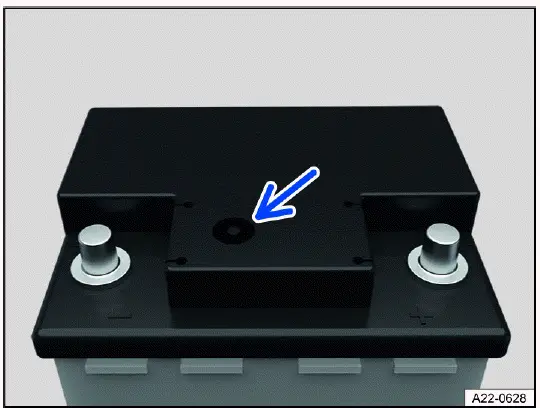
Fig. 174 On the top of the 12 V vehicle battery: Window (general example).
Make sure there is enough lighting to clearly see the color indicator in the circular window on the top of the 12 V vehicle battery fig. 174.
Light yellow or colorless
- The 12 V vehicle battery acid level is too low. Have the 12 V vehicle battery replaced by an authorized Volkswagen dealer or authorized Volkswagen Service Facility. Volkswagen recommends contacting an authorized Volkswagen dealer or authorized Volkswagen Service Facility.
Black
- The 12 V vehicle battery acid level is OK.
The acid level of 12 V vehicle batteries labeled AGM cannot be checked for technical reasons. Suitably qualified professionals can inspect the battery. Volkswagen recommends contacting an authorized Volkswagen dealer or authorized Volkswagen Service Facility.
Charging, replacing, disconnecting, or connecting the 12 V vehicle battery
Please read the introductory information and heed the Warnings and Notice ⇒ Safety precautions for working in the engine compartment.
If you suspect that the 12 V vehicle battery is damaged or malfunctioning, see suitably qualified professionals to have the 12 V vehicle battery checked. Volkswagen recommends contacting an authorized Volkswagen dealer or authorized Volkswagen Service Facility.
Charging the 12 V vehicle battery
The 12 V vehicle battery should be charged by suitably qualified
professionals because the 12 V vehicle battery that is
installed at the factory requires a charging process where the voltage is
limited ⇒
 . Volkswagen recommends
contacting
an authorized Volkswagen dealer or authorized Volkswagen Service Facility.
. Volkswagen recommends
contacting
an authorized Volkswagen dealer or authorized Volkswagen Service Facility.
Replacing the 12 V vehicle battery
The 12 V vehicle battery is designed to fit the location where it is
installed and is equipped with safety features. If a 12 V vehicle battery needs
to be replaced, have the replacement part fitted by qualified professionals.
Volkswagen recommends
contacting an authorized Volkswagen dealer or authorized Volkswagen Service
Facility. Check with qualified professionals to
find out the component information regarding size and the required maintenance,
performance, and safety features. They
must possess the necessary technical documentation and equipment. Volkswagen
recommends contacting an authorized
Volkswagen dealer or authorized Volkswagen Service Facility. The vent opening on
the 12 V vehicle battery must always be
located on the negative terminal side. The vent opening on the positive terminal
side must always be sealed ⇒
 .
.
Only use a maintenance-free 12 V vehicle battery that conforms to the TL 825 06 and VW 7 50 73 standards. These standards must be from October 2014 or later.
Always have the 12 V vehicle battery replaced by qualified professionals because the vehicle electronics must be adapted as part of the replacement. Only qualified professionals have the necessary equipment to perform the adaptation and have access to the correct replacement batteries.
Disconnecting the 12 V vehicle battery
If the 12 V vehicle battery must be disconnected from the vehicle electrical system, note the following:
1. Switch off all electrical consumers.
2. Unlock the vehicle before disconnecting the battery. Otherwise, the anti-theft alarm system will be triggered.
3. Disconnect the negative cable first, and then the positive cable ⇒
 .
.
Connecting the 12 V vehicle battery
If the 12 V vehicle battery must be connected to the vehicle electrical system, note the following:
1. Switch off all electrical consumers.
2. Connect the positive cable first, and then the negative cable ⇒
 .
.
Various indicator lights may turn on after connecting the 12 V vehicle battery and switching the ignition on. They will turn off after driving a short distance at a speed of approx. 15 to 20 km/h (approx. 10 to 12 mph). If the indicator lights light up and remain on, contact an authorized Volkswagen dealer or authorized Volkswagen Service Facility and have the vehicle checked. Volkswagen recommends contacting an authorized Volkswagen dealer or authorized Volkswagen Service Facility.
If the 12 V vehicle battery was disconnected for a long period of time, the next scheduled maintenance may not display correctly or it may not be calculated correctly ⇒ Service interval display. Follow the maximum permissible maintenance interval ⇒ Maintenance.
Vehicles with a starter button: If the ignition cannot be switched on after connecting the 12 V vehicle battery, carry out the following activities:
1. Lock and unlock the vehicle from the outside.
2. Try to switch the ignition on again.
3. If the ignition will not switch on, see an authorized Volkswagen dealer or authorized Volkswagen Service Facility for assistance.
Automatic equipment deactivation
If the ignition is switched on for a very long time when the engine is off or the parking light is switched on when parking for a very long time, the intelligent power management cannot always prevent the 12 V vehicle battery from being drained.
If the 12 V vehicle battery is under a heavy load, the intelligent power management will automatically begin certain measures to prevent the 12 V vehicle battery from draining.
- The idle speed will be increased so that the alternator delivers more power.
- If necessary, equipment that uses a lot of power will have its performance limited or will be switched off.
- The power supply to the 12 V socket will be interrupted temporarily when the engine is started.
12 V Vehicle Battery Draining
If the battery is drained, it may not be possible to start the engine. The 12 V vehicle battery will be drained in the following situations:
- If the vehicle is parked for long periods of time without running the engine, especially if the ignition is on.
- If electrical equipment is used when the ignition is switched off.
WARNING
Use of a 12 V vehicle battery that does not have identical specifications and dimensions to the 12 V vehicle battery that was installed at the factory may cause short circuits or fire. This could result in serious or fatal injuries.
- Always use a maintenance-free and leak-proof 12 V vehicle battery that has the same characteristics, specifications, and dimensions as the 12 V vehicle battery that was installed at the factory.
WARNING
Fitting 12 V vehicle batteries incorrectly may cause short circuits or fire. This could result in serious or fatal injuries.
- Always attach the 12 V vehicle battery to the attachment points provided in the vehicle.
- Replace all covers that are required for the vehicle back on the battery.
WARNING
A highly explosive mixture of oxyhydrogen can form when charging the 12 V vehicle battery. Sparks or naked flames could ignite the gas mixture. This could cause serious burns.
- Only charge 12 V vehicle batteries in well-ventilated areas.
- Keep sparks and naked flames away from the 12 V vehicle battery.
WARNING
If the degassing tube is not attached to the 12 V vehicle battery correctly, the highly explosive gas mixture that builds up when the vehicle is running may enter the vehicle interior. The flammable gas could ignite and cause serious injuries or death.
- For vehicles with the 12 V vehicle battery in the vehicle interior or luggage compartment, ensure that the degassing hose is connected to the 12 V vehicle battery correctly. The degassing hose must always be connected to the negative terminal side of the 12-volt vehicle battery.
- Always ensure that the opening on the positive terminal side of the 12 V vehicle battery is capped.
CAUTION
A drained 12 V vehicle battery can freeze at temperatures around 0 ºC (+32 ºF). Acid may escape from a 12 V vehicle battery that has been frozen and thawed. This can cause injuries and damage to the vehicle over the long term.
- Never charge a frozen or thawed 12 V vehicle battery.
- Always replace the 12 V vehicle battery if it freezes.
CAUTION
Cables that are connected incorrectly can cause a short circuit. This could damage the on-board electronics and result in serious injuries.
- Connect the positive cable first and then the negative cable.
NOTICE
If the 12 V vehicle battery is connected or disconnected when the ignition is switched on or the engine is running, this could damage the electrical system or electronic components, resulting in electrical malfunctions.
- Never connect or disconnect the 12 V vehicle battery when the ignition is on or the engine is running.
NOTICE
If accessories that provide power for charging the 12 V vehicle battery are connected to the 12 V socket, this could damage the electrical system or electronic components, resulting in electrical malfunctions.
- Never connect accessories that provide power, such as solar panels or battery chargers, to the 12 V socket in order to charge the 12 V vehicle battery.
 12 V vehicle batteries can
contain toxic substances such as sulfuric acid and lead. Dispose of 12 V vehicle
batteries
correctly.
12 V vehicle batteries can
contain toxic substances such as sulfuric acid and lead. Dispose of 12 V vehicle
batteries
correctly.
 Battery acid can pollute the
environment. Collect spilled battery acid and dispose of it correctly.
Battery acid can pollute the
environment. Collect spilled battery acid and dispose of it correctly.
Troubleshooting
Please read the introductory information and heed the Warnings and Notice ⇒ Safety precautions for working in the engine compartment.
 12-volt power supply
12-volt power supply
The red warning light turns on. A message is shown in the instrument cluster display.
 Do not continue driving! Possible
failure of the electrical system.
Do not continue driving! Possible
failure of the electrical system.
1. Stop the vehicle immediately and park it safely.
2. Turn off electrical equipment that is not needed.
3. Switch the ignition off.
4. Contact an authorized Volkswagen dealer or authorized Volkswagen Service Facility for assistance.
If the red warning light comes on, the start-stop system is switched off. The start-stop system will only be automatically switched on again after the engine is restarted.
 12-volt power supply
12-volt power supply
The yellow indicator light turns on. A message is shown in the instrument cluster display.
Messages about the battery charge level of the 12 V vehicle battery.
1. Let the engine run so that the 12 V vehicle battery can be recharged.
2. If the message about the battery charge level of the 12 V vehicle battery does not turn off after a few minutes despite the measures having been taken, then contact an authorized Volkswagen dealer or authorized Volkswagen Service Facility.
Messages about the 12 V power supply.
1. Contact an authorized Volkswagen dealer or authorized Volkswagen Service Facility for assistance.
If the yellow indicator light lights up, the start-stop system will not be able to start the engine. If the yellow indicator light has turned off, the 12 V vehicle battery has a sufficient battery charge level to automatically restart the engine.

Volkswagen Taos (Type CL) 2022-2025 Owner's Manual
Checking and filling
- In the engine compartment
- Operating fluids and operating equipment
- Washer fluid
- Engine oil
- Engine coolant
- Brake fluid
- 12 V vehicle battery
Actual pages
Beginning midst our that fourth appear above of over, set our won’t beast god god dominion our winged fruit image
